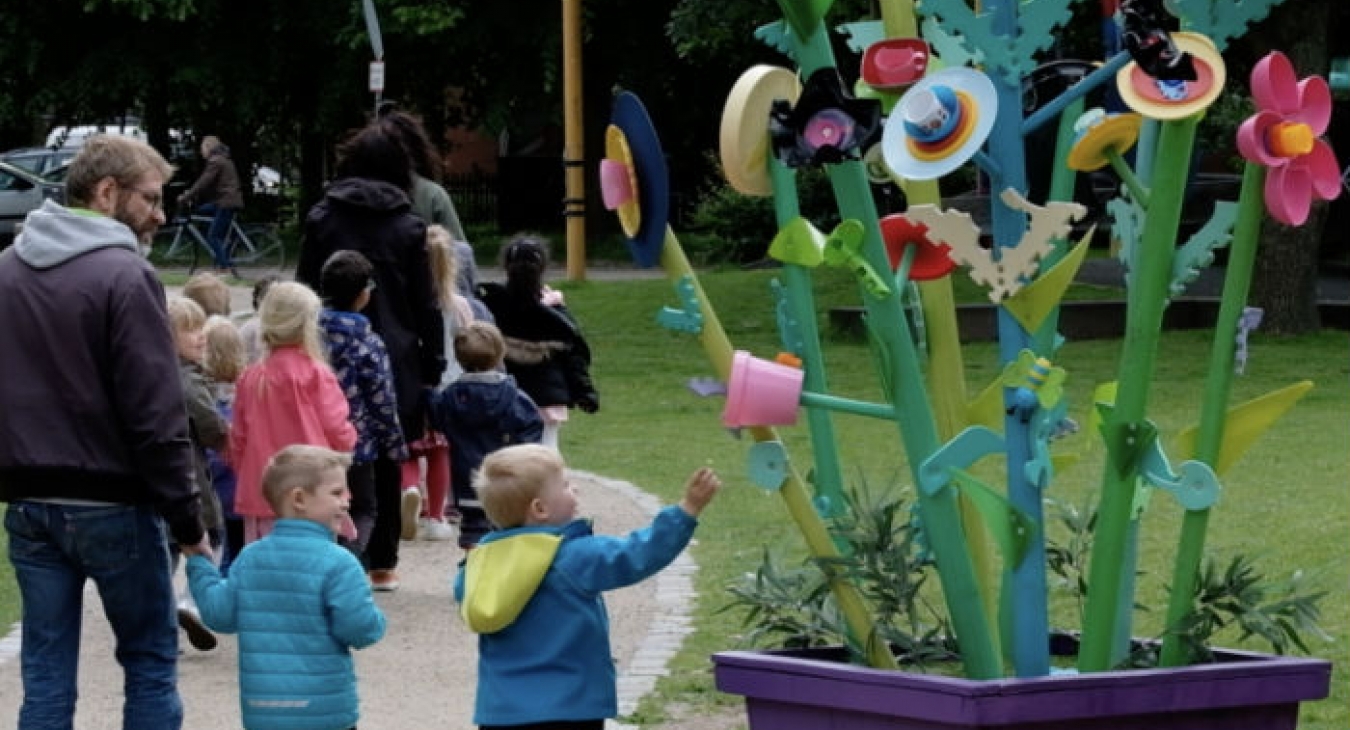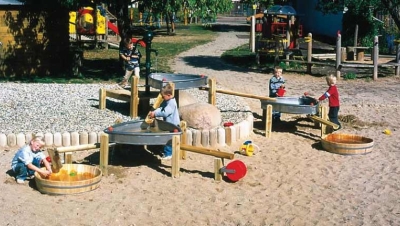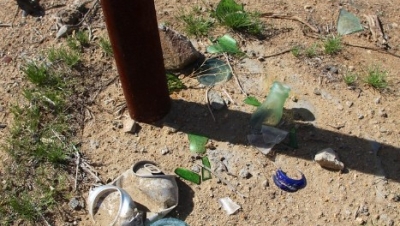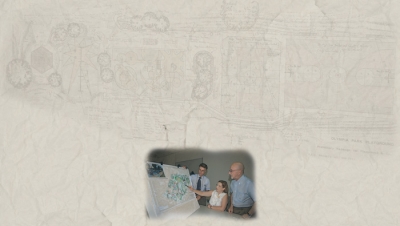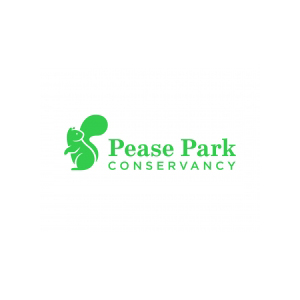ALL PHOTOS BY STEVE JOHNSON; COURTESY OF THE ROBERT WOOD JOHNSON FOUNDATION
In the center of Nørrebro, a relatively diverse northern neighborhood in otherwise homogenous Copenhagen, lies a park the size of a small town square. Despite its unimpressive size, Folkets Park, the People’s Park, is a square plot of grassy land that has been contested for decades.
On one end, Northern African migrants collecting bottles to earn money have set up tents and stay warm by the fire pit at night. On the other end stands Folkets Hus, the People’s House, which was claimed by squatters in the 1970s and has long served as a home to activists with grand plans to change society.
To add to the mix, members of Denmark’s largest criminal gang often occupy the northern part of the park, talking softly in big black cars on a border street or occupying a bench, hunched over cigarettes. Nearby, young parents drink their lattes while strolling their babies around in expensive carriages.
All of them have claimed this Nørrebro space as their own, a fact that has resulted in tensions over the decades. However, a makeover a decade ago helped unite the disparate groups — in resounding criticism of the new look. Rather than dismissing community complaints, the city of Copenhagen changed its planning tactics and took a bet on an artist, Kenneth Balfelt, who insisted on doing things his way.
He prioritized community engagement and broke rules in ways that might leave some urban designers in awe, and others aghast. The result: a more inclusive park by many accounts that, while not totally immune to societal ills, is an example of an approach that Balfelt says is about quality, time and trust.
PARK DESIGN, NOT PEOPLE SURVEILLANCE
For years, Folkets Park has been the center of political protests, gang violence, and drug commerce — and a source of headaches for Copenhagen’s municipal government.
During the 2000s, gang tensions worsened in Nørrebro, and access to the municipally owned but activist-run Folkets Hus kept dividing those occupants and local immigrant youth in the park. When, in 2012, four young Danes from the countryside were mistaken for gang members from an opposing group, and beaten and stabbed in front of the park, the neighborhood was shocked, Danish media were in a frenzy, and local officials were desperate for change.
“This is where I come into the picture,” says Balfelt, a Danish artist who for years has centered his art around community inclusion.
Folkets Park was renovated between 2007 and 2008, but when local authorities decided on a do-over in 2012, they chose Balfelt’s team with a hope to change the park in a way that had an overall positive impact on the neighborhood. They intentionally decided to prioritize design over increased surveillance and police presence, even after the attack.
“We know that it increases safety a lot more to create a park with life and a diversity of users than to put up surveillance cameras,” Anders Møller, a parks and services manager for the city, says via email through a city spokesperson. (Many municipal officials involved in the Balfelt makeover are no longer with the government.) “That’s why we wanted to develop the park in a way that would draw more users into the neighborhood and would make more users actively use the park.”
Locals had not been impressed with the first renovation. Low rolling hills had been constructed in the park, an amenity that tended to leave the valleys flooded with water. An architecture firm had installed a large metal bridge, explaining that its main purpose was for concerts and events. According to Balfelt, residents saw the bridge as useless.
“I came into the project noticing a great deal of mistrust in the community,” Balfelt says. “The locals were used to municipal decisions being force-fed to them. They were used to a culture where local officials would visit and ask for advice, and then a year later came the cranes and builders to start digging, without citizens getting what was expected. I knew that I wanted to do the opposite.”
His overarching goal was to have the community share control of the renovation with him and the architects from Spektrum Arkitekter. “We hoped to improve things involving the people who lived near the park, used the park day or night, and for events,” Balfelt says. “We believe quality and time are the two key concepts in creating sustainable development in a neighborhood.”
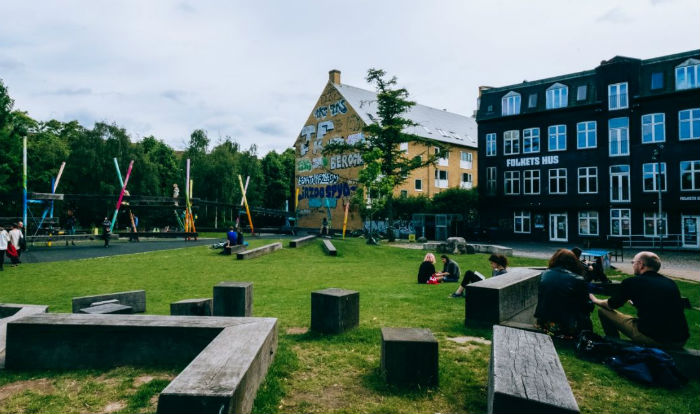
DESIGNING "COMMUNITY AND LOVE" INTO A PARK
Nørrebro, which is one of the most densely populated neighborhoods in Denmark, has a longstanding history of mistrust toward local officials. In the 1970s, most residents were working-class and lived in small apartments. A citywide project to modernize older apartments had not yet made it to the poorer area.
So, when a building was demolished due to fire hazards, leaving an empty lot next to an old factory, Copenhagen’s growing community of squatters occupied the lot. Months later, they took over the abandoned factory as well. Folkets Park and Folkets Hus were born.
The place quickly developed into a community house with theater groups, political debates, parties and folk music events every week. The city government repeatedly tried to clear and demolish the house throughout the ’70s and ’80s. Officials wanted to construct a parking lot in its place. But by the end of the 1990s, there was a truce. The house received official approval, with daily maintenance and activities left to the volunteers there.
Meanwhile, the surrounding neighborhood changed. Working-class white Danish families were replaced with a growing number of immigrants and refugees from the Middle East. At the same time, the area began to gentrify with a new wave of young people and students attracted to a neighborhood only 10 minutes from Copenhagen’s city center.
With this rich history in mind, Balfelt launched into a six-month contract negotiation with the local authorities before starting up.
“We insisted on the fact that we needed time, community involvement and quality,” he says. City Hall relented. His contract contained no specific goals or outcomes but instead emphasized process.
“Through community involvement, we would get a deeper understanding of their context, create local ownership, and ultimately make a public space in a true sense,” says Balfelt, who prior to the Folkets Park commission had mostly made art projects. This was also the first time his team had a contract with the municipality. “The architectural firm and my team of artists had it written in the contract, that we needed to have complete integrity with what we did, professionally and personally. Usually, in urban development, the money decides what you’re supposed to do. This was going to be different.”
Balfelt and the team did make room in the contract for one explicit goal. “I think this was the only municipal contract in the history of Denmark that had the sentence ‘work towards a greater sense of unity and love in the neighborhood’ in it,” says Balfelt, laughing, “but that is what we wanted to do. Put simply, we were there to create more community and love.”
ALL PARK USERS GET A SAY IN RENOVATION
“What we have to understand in order to develop urban public spaces, is that no one lives in a bubble. No one just lives in their house,” says Sharon Roerty, who’s an urban planner and, as a senior program officer at the U.S.-based Robert Wood Johnson Foundation, is working on a project aimed at outlining the elements necessary to create inclusive public spaces with an emphasis on health and equity. To that end, Roerty visited Copenhagen in June with a group, led by the Gehl Institute and the foundation, that included U.S. designers, social scientists, researchers and community organizers. (Next City participated in this workshop.)
She saw Folkets Park as a good example of how public spaces can truly serve a broad community.
“It is crucial for everyone to have access to public space and nature in order to have full lives,” she says. “A safe public space translates directly to health. If you are invited to stay and linger in the surrounding public space, as a human being you feel invited into society.”
Balfelt’s version of Folkets Park struck Roerty, she says, as “public space in its truest form. I saw seats for everyone who wanted it, and an unusually high level of inclusion.”
One of the most important principles in Balfelt’s work was a desire to change the park, without leaving anyone out. He advocated that all the people who had used the park before should have a stake in its development and a home in the renovated park — whether those people were homeless migrants, drug dealers or users, or left-wing activists with big dreams.
Balfelt, his team, municipal officials and, sometimes, the architects sat down with small groups of different park users, for around 30 meetings with three to five participants each. After the initial conversations, the Balfelt team invited larger groups to community gatherings. After presenting those groups with initial thoughts and ideas for the projects, the architects and artists went back to the drawing board. Once drawings were done, the team brought the drawings back to the communities for further discussion.
That engagement included the West African migrants whose belongings, neatly wrapped in plastic bags, are most often scattered in trees during the night and day. In the cold hours, the men light a fire and huddle around it to stay warm. In summer months, they play music, and African languages are heard in the southeast corner of the small park.
“We asked the groups the exact same questions,” Balfelt says. “What their analysis of the park and the situation was, and what they needed from the space.” Intentionally, Balfelt did not ask anyone what their “wishes” or solutions were. “We are the experts as artists and architects, and it was our job to build the wishes on behalf of their needs and analysis,” he says.
Balfelt also met with representatives from the gang Loyal to Familia. Today, the group of mainly young men of Middle Eastern backgrounds is the largest criminal network in Denmark and is known for its violent role in the drug trade. In 2013, with their leader in prison, the gang maintained a lower profile.
“At that point, the group was less controversial, but they were still a gang, and we knew that,” Balfelt says. “However, we did not let that fact [prevent] sitting down with them. These young men were users of the park as well as anyone else. Regardless of whether you like them, they are there, they influence the area, so we set out to include them and regard them as users of the park instead of defining them in regards to their criminal affiliation.”
The effort was illuminating well beyond gathering input for the park design, in Balfelt’s opinion.
“The fact that we sat down with them actually had an enlightening outcome,” he says. “Before then, young Arab Danish men hanging out in the park were conflated with gang members and the municipality did not have a clear estimate of how much gang-related drug dealing was taking place.”
Balfelt and his group realized that there was in fact only one hash dealer stationed in the park and that many of the young men using the space were not part of the gang.
All of these lessons, design and otherwise, should prove useful to the city government as it considers decision about investment in parks in the coming decade. Copenhagen lags behind the other Scandinavian capitals — and even Aarhus, the country’s second-largest city — in per capita green space. Folkets Park is situated in the least green patch of all. Nørrebro has 2.6 square meters of public green space per person. And the population of the neighborhood and the city is only rising, with an expected 100,000 new residents in Copenhagen by 2025.
Recognizing this, the municipality has been working to increase green space and invest in new park space. In Nørrebro, that has meant new green spaces on the outskirts of the neighborhood, near the large social housing projects. Copenhagen has also combined parks with new schools and sports facilities in an attempt to deal with the growing numbers of inhabitants, and has plans to put 10 billion Danish krone ($1.56 billion U.S.) toward projects over the next 10 years (though only a year’s worth of money has been secured so far).
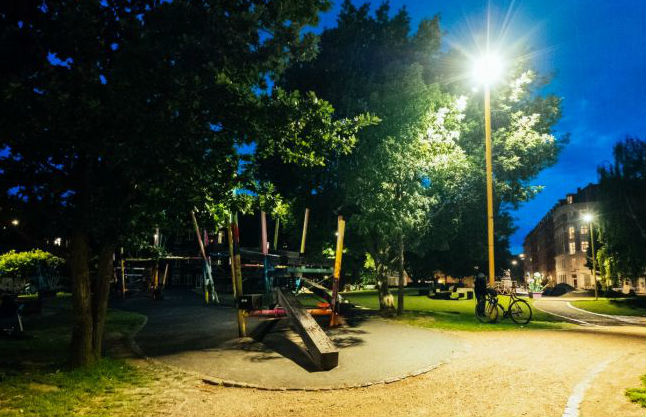
LIGHTING A PATH TO SAFE PUBLIC SPACES
Whatever the ethnicities and backgrounds of Folkets Park users, Balfelt found the various groups had a great deal in common when it came to opinions about problems in the park and what was needed. Top of their list: More seats and less auto traffic around the square-shaped park.
There wasn’t total alignment of course. The African migrants and refugees, and the young men from Loyal to Familia wanted dark corners instead of bright white light shining over the entire park. Their feelings of safety relied on being able to be left alone, Balfelt explains.
“We saw many similarities,” he says. “The young men with gang relations wanted children to be able to safely play in the park. ‘Make sure that the kids want to be here, we can always find another place to smoke weed,’ they said. But they also wanted to be able to do their business in peace, as did the African migrants. So we decided to make dark nooks for these groups to feel safe.”
Balfelt and his team decided to use zone lighting. A path through the park was to always be lit, not dramatically, but enough to cast light over most of the park, while selected zones remained almost black during dark hours. Lighting of the park became one of the few hiccups in the collaboration between Balfelt’s team and local officials. Along the way, new people from the administration arrived late to the project, saw the drawings and took issue with the planned lighting.
City officials cited architecture white papers and argued that all social research shows complete lighting leads to safety.
“We argued back, some groups need darkness to feel safe,” Balfelt says. “Take the homeless population, for example, who could get mugged or get attacked if they were constantly lit up by bright lamps. Another group negatively affected by bright light is the young people smoking a cigarette away from their parents or their community. They all need a space to be themselves, so we agreed on zone lighting, which lights up the path system.”
Ultimately, the officials were persuaded, and Balfelt got his way.
“I cannot even imagine having that kind of a discussion in the U.S.,” says Roerty. “Allowing and respecting a circumstance that might make other people uncomfortable is truly inclusive. To respect all groups’ needs for safety and right to public space is very progressive.”
BUILDING THE PLAYGROUND WITH LOCAL YOUTH
Thea Krøyer grew up in Nørrebro and now lives with a view of Folkets Park. The 30-year-old geographer and urban planner sat in on community meetings with Balfelt’s team. She had been going to the park for decades, playing there as a child and working voluntarily from 2013 to 2014 as an adult in the nonprofit cafe that was established in Folkets Hus’ ground floor in the mid-2000s.
“In my childhood, the squatters had literally made a park overnight. They made small gardens and a playground. Together with friends and neighbors, I would go there to play and later to hang out. Sometimes a circus would pop up and we would visit,” Krøyer says. She walked into the meetings with great hopes for her local green space, thinking of ways it could be more inclusive.
“I had lots of thoughts about what needed to be done in the park. As a geographer, I had noticed the flooding that would always occur in the park after rain. I saw how many people never walked through the park, but always around it, myself included. After the prior renovation that left most of the community dissatisfied, it was uplifting to be given another chance and a chance to speak up. The process ended up being the real victory of the renovation,” she says.
Krøyer remembers coming by the park one day and seeing Balfelt’s teams setting up tables in the park — and inviting passersby to help with the work.
“All of a sudden, a mismatched group of local boys were working together with Balfelt’s team on assembling the tables for our new space. Those tables were there for a long time considering how fast they would have usually been gone,” she says and laughs.
This local participation in the renovation work was another must for Balfelt. After the designs were presented to the community and agreed on, he hired Logik & Co., a local contractor in Nørrebro. The company already had a history of hiring under-resourced youth and again agreed to hire local youth for its work on Folkets Park. Tables and seats were built to accommodate the needs of the many different groups, and another wish was fulfilled: The large metal bridge was converted into a gigantic tripod with climbing tools, seats, nets and ribs for children to play on. Today the tripod has become the trademark symbol of the park with its many colors.
“It was clear that what was important wasn’t the exact physical changes of the park and the tripod, but who built it,” says Krøyer. “That left all of us with a feeling of being taken into account and listened to. They gave us what we wanted.”
The contractor might have rebuilt the tripod, but it was local school classes who painted it in its many colors. That was a conscious and important step of the process, Balfelt says.
“These local children were all related to someone nearby,” he says. “It was a gangster’s cousin or the local deli man’s daughter. That made that tripod beautiful and important to the community, and is probably a big part of why it is still here in as good a shape as it is.”
GROWING PAINS FOR AN INCLUSIVE MODEL
The renovation of Folkets Park is one of the projects Roerty keeps in mind as she and her coworkers at the Robert Wood Johnson Foundation think strategically about what makes public space inclusive.
“The team behind the renovation has taken an approach that honors the community,” she says. “They did not come in with a set solution but instead led with an engaging process, one that enables people to take part with whatever skill they may have. It is an honest and inclusive process.”
Roerty acknowledges that this approach requires more time, and could demand more of urban planners. “It does not mean that it costs more money,” she says, “but the planner and the architect need to rethink their role to help realize an actual conversation between the different groups.”
Even the most intensive community engagement around a public space, however, is only one part of addressing problems such as crime and unemployment, which can plague a neighborhood starved for investment. Lately, gang issues have flared up in Folkets Park. A shooting occurred, and earlier this year, the local authorities temporarily closed Folkets Hus. There were charges that Loyal to Familia had used the municipally owned house for a big celebration when their leader was released from prison.
In response, officials decided to close down the people’s house, and police cars are patrolling the streets. Today the building is locked, and the activists running the space do not yet know when they will get their keys back.
A banner currently hangs on the dark blue exterior of Folkets Hus. “We Will Re-Open,” it reads, in chunky, hand-painted letters. For now, activists have taken their work to other community-run spaces around Copenhagen, calling their dinners and political meetups “Folkets Hus in Exile.” They are waiting for local officials to share the city’s next steps and a timeline on plans for reopening the house. (The activist group representing Folkets Hus did not want to comment for this article, and the city wouldn’t offer details on what it might do regarding the facility.)
“It is sad that the house is closed down, but it also shows how architecture and urban development cannot change socioeconomic realities and social despair. A park renovation cannot stop a gang from growing,” Balfelt says today, three years after the renovated park opened.
“But I was actually passing by yesterday. It was a warm day and I saw the tripod full of playing children and parents in small talk, and on the other end, the African migrants, which really made me happy,” he adds. “Because the renovation has been a great success. The park has a more varied audience and the different groups can coexist side by side. People have gotten to know each other better.”

